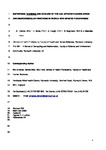Superficial warming and cooling of the leg affects walking speed and neuromuscular impairments in people with spastic paraparesis
| dc.contributor.author | Denton, Amanda | |
| dc.contributor.author | Bunn, Lisa | |
| dc.contributor.author | Hough, A | |
| dc.contributor.author | Bugmann, Guido | |
| dc.contributor.author | Marsden, Jonathan | |
| dc.date.accessioned | 2016-11-17T17:05:16Z | |
| dc.date.available | 2016-11-17T17:05:16Z | |
| dc.date.issued | 2016-12 | |
| dc.identifier.issn | 1877-0657 | |
| dc.identifier.issn | 1877-0665 | |
| dc.identifier.uri | http://hdl.handle.net/10026.1/6759 | |
| dc.description | publisher: Elsevier articletitle: Superficial warming and cooling of the leg affects walking speed and neuromuscular impairments in people with spastic paraparesis journaltitle: Annals of Physical and Rehabilitation Medicine articlelink: http://dx.doi.org/10.1016/j.rehab.2016.04.006 content_type: article copyright: © 2016 Elsevier Masson SAS. All rights reserved. | |
| dc.description.abstract |
BACKGROUND: People with hereditary and spontaneous spastic paraparesis (HSSP) report that their legs are stiffer and walking is slower when their legs are cold. OBJECTIVES: This study explored the effects of prolonged superficial cooling and warming of the lower leg on walking speed and local measures of neuromuscular impairments. METHODS: This was a randomised pre- and post-intervention study of 22 HSSP participants and 19 matched healthy controls. On 2 separate occasions, one lower leg was cooled or warmed. Measurements included walking speed and measures of lower limb impairment: ankle movement, passive muscle stiffness, spasticity (stretch reflex size), amplitude and rate of force generation in dorsi- and plantarflexors and central and peripheral nerve conduction time/velocity. RESULTS: For both participants and controls, cooling decreased walking speed, especially for HSSP participants. For both groups, cooling decreased the dorsiflexor rate and amplitude of force generation and peripheral nerve conduction velocity and increased spasticity. Warming increased dorsiflexor rate of force generation and nerve conduction velocity and decreased spasticity. CONCLUSIONS: Superficial cooling significantly reduced walking speed for people with HSSP. Temperature changes were associated with changes in neuromuscular impairments for both people with spastic paraparesis and controls. This study does not support the use of localised cooling in rehabilitation for people with spastic paraparesis as reported in other neurological conditions. Rehabilitation interventions that help prevent heat loss (insulation) or improve limb temperature via passive or active means, particularly when the legs and/or environment are cool, may benefit people with spastic paraparesis. | |
| dc.format.extent | 326-332 | |
| dc.format.medium | Print-Electronic | |
| dc.language | en | |
| dc.language.iso | en | |
| dc.publisher | Elsevier BV | |
| dc.subject | Temperature | |
| dc.subject | Neural conduction | |
| dc.subject | Muscle spasticity | |
| dc.subject | Spastic paraparesis | |
| dc.title | Superficial warming and cooling of the leg affects walking speed and neuromuscular impairments in people with spastic paraparesis | |
| dc.type | journal-article | |
| dc.type | Clinical Study | |
| dc.type | Journal Article | |
| plymouth.author-url | https://www.webofscience.com/api/gateway?GWVersion=2&SrcApp=PARTNER_APP&SrcAuth=LinksAMR&KeyUT=WOS:000416911000007&DestLinkType=FullRecord&DestApp=ALL_WOS&UsrCustomerID=11bb513d99f797142bcfeffcc58ea008 | |
| plymouth.issue | 5-6 | |
| plymouth.volume | 59 | |
| plymouth.publication-status | Published | |
| plymouth.journal | Annals of Physical and Rehabilitation Medicine | |
| dc.identifier.doi | 10.1016/j.rehab.2016.04.006 | |
| plymouth.organisational-group | /Plymouth | |
| plymouth.organisational-group | /Plymouth/Faculty of Health | |
| plymouth.organisational-group | /Plymouth/Faculty of Health/School of Health Professions | |
| plymouth.organisational-group | /Plymouth/Faculty of Science and Engineering | |
| plymouth.organisational-group | /Plymouth/REF 2021 Researchers by UoA | |
| plymouth.organisational-group | /Plymouth/REF 2021 Researchers by UoA/UoA03 Allied Health Professions, Dentistry, Nursing and Pharmacy | |
| plymouth.organisational-group | /Plymouth/Research Groups | |
| plymouth.organisational-group | /Plymouth/Research Groups/FoH - Applied Parkinson's Research | |
| plymouth.organisational-group | /Plymouth/Research Groups/Institute of Health and Community | |
| plymouth.organisational-group | /Plymouth/Research Groups/Marine Institute | |
| plymouth.organisational-group | /Plymouth/Users by role | |
| plymouth.organisational-group | /Plymouth/Users by role/Academics | |
| dc.publisher.place | Netherlands | |
| dcterms.dateAccepted | 2016-04-14 | |
| dc.rights.embargodate | 2017-6-1 | |
| dc.identifier.eissn | 1877-0665 | |
| dc.rights.embargoperiod | 12 months | |
| rioxxterms.versionofrecord | 10.1016/j.rehab.2016.04.006 | |
| rioxxterms.licenseref.uri | http://www.rioxx.net/licenses/under-embargo-all-rights-reserved | |
| rioxxterms.licenseref.startdate | 2016-12 | |
| rioxxterms.type | Journal Article/Review |


